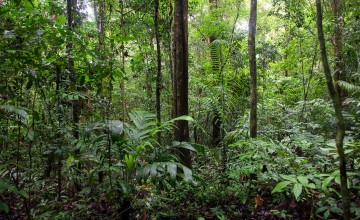
Helene
Muller–Landau
Tropical forests vary widely in their structure, productivity, tree death rates, and the relative abundance of trees of different heights, wood properties, drought vulnerability, etc. What are the mechanisms underlying this variation, and how can we capture these mechanisms in models to better understand and predict tropical forests responses to human influences?
Projects and Stories
Research Focus
Research in my lab seeks to understand the processes determining tropical forest biomass, dynamics, plant species composition, and diversity, and their variation within and among sites and over time. The biomass of a forest reflects the interplay of wood production via growth and loss via mortality, with growth and mortality rates in turn depending on climate and soils, and the responses of local plant species to these conditions. The relative abundances of plants having different environmental responses themselves vary considerably among tropical forests together with climate, soils, and human influences, and any one tropical forest invariably contains many co-occurring plant species varying widely in their traits. Our research thus encompasses a wide variety of topics in community and ecosystem ecology, which we study through a combination of field research, data analysis, and modelling.
Additional links
Contact
Research Overview
How and why do carbon stores and fluxes vary among tropical forests?
Mechanistic, physiologically based models can explain much of the variation in forest productivity with climate and soils, but little of the variation in mortality fluxes and biomass stocks. As lead scientist of the Forest Carbon Research Initiative for the Center for Tropical Forest Science-Forest Global Earth Observatory (CTFS-ForestGEO), I strive to implement standardized measurements of forest carbon stocks and fluxes across this network of forest plots, assist network collaborators with associated analyses and manuscripts, and contribute to related syntheses. My lab is also quantifying landscape-scale variation in forest canopy structure and dynamics in Panama using camera-carrying unmanned aerial vehicles and photogrammetry.
What drives variation in the abundances of lianas and vines within and among tropical forests?
Lianas (woody climbing plants) and vines (nonwoody climbing plants) vary widely in abundance within and among tropical forests, with important implications for forest carbon budgets. Lianas and vines reduce tree growth, increase tree mortality rates, and alter forest structure and composition. Past studies have established that climbing plants are more abundant in drier forests, younger forests, and on edges – but scientists currently lack a mechanistic understanding for what determines their abundance in any forest, much less its variation across forests. We are pursuing a variety of empirical and theoretical studies to identify the factors that control the abundances of these structural parasites.
What mechanisms explain the high diversity of plant species co-occurring within tropical forests?
Individual tropical forests commonly contain >100 woody plant species in an area the size of a football field, and can contain >1,000 species in a square kilometer. Ecologists have long debated what mechanisms prevent one or a few species from outcompeting and excluding the others. Tradeoffs in performance among spatially varying habitats and temporally varying climate conditions clearly play a role, as do interactions with specialized natural enemies that tend to disproportionately plague and disadvantage any given species in areas where it is locally more common. We work to evaluate the strength of different mechanism and quantify their roles through a combination of theory and empirical analyses.
What explains variation in functional traits among co-occurring plant species?
Co-occurring plant species differ tremendously in their life history strategies and in related functional traits. A classic example is seed mass, which commonly varies more than 1-million-fold among tree species within any given tropical forest. The persistence of this variation clearly indicates that one or more underlying tradeoffs prevents any one strategy from being everywhere superior. But what exactly are these underlying tradeoffs? Using mutually informed theoretical development and empirical analyses, we seek to identify the underlying tradeoffs and capture them mechanistically in sufficient detail to quantitatively explain observed patterns of variation.
How can we improve the representation of tropical forests in earth system models?
Earth system models (ESMs) simulate the earth’s climate system and its interaction with vegetation, and are used to predict the influences of policy scenarios on future atmospheric composition and climates. Among other things, these models simulate the feedbacks between tropical forests and the climate system. However, these models are currently unable to correctly capture observed spatial and temporal variation in tropical forest carbon budgets, and diverge wildly in their predictions of future responses. We are collaborating with two ESM development teams to improve the representation of tropical forests in these models by building more accurate representations of key processes and improving parameter estimates. Visit the pages NGEE-Tropics and GFLD LM3 for more details.
What are the patterns, causes, and consequences of variation in leaf phenology – the timing of leaf flushing and leaf senescence?
The amount of leaf area deployed and the age distribution of leaves varies seasonally and interannually in tropical forests in relation to climate, and is critical to determining temporal variation in ecosystem carbon, water, and energy fluxes. We hypothesize that interspecific variation in phenology is a key determinant of which species thrive in drier vs. wetter forests, in sunnier vs. cloudier years, and in rich vs. poor soils. We are quantifying the phenology of thousands of trees using camera-carrying unmanned aerial vehicles; analyzing how individual tree and liana phenology relates to temporal climate variation, spatial environmental variation, and species traits; and evaluating the implications of phenology for ecosystem fluxes by integrating these data with models.
Education
B.A., Mathematics and Statistics, Swarthmore College, 1995
M.A., Ecology and Evolutionary Biology, Princeton University, 1997
Ph.D., Ecology and Evolutionary Biology, Princeton University, 2001
Selected Publications
Muller-Landau, H. C., K. C. Cushman, E. E. Arroyo, I. Martinez Cano, K. J. Anderson-Teixeira, and B. Backiel. 2021. Patterns and mechanisms of spatial variation in tropical forest productivity, woody residence time, and biomass. New Phytologist 229:3065-3087. https://doi.org/10.1111/nph.17084 (Commissioned Tansley review)
Cushman, K. C., M. Detto, M. García, and H. C. Muller-Landau. 2022. Soils and topography control natural disturbance rates and thereby forest structure in a lowland tropical landscape. Ecology Letters 25:1126-1138. https://doi.org/10.1111/ele.13978
Muller-Landau, H. C. and S. W. Pacala. 2020. What determines the abundance of lianas and vines? Pages 239-264 in Unsolved Problems in Ecology, edited by A. Dobson, D. Tilman, and R. D. Holt. Princeton University Press. Awarded the Smithsonian Secretary’s Research Prize for 2020.
Martínez Cano I, E. Shevliakova, S. Malyshev, S. J. Wright, M. Detto, S. W. Pacala, and H. C. Muller-Landau. 2020. Allometric constraints and competition enable the simulation of size structure and carbon fluxes in a dynamic vegetation model of tropical forests (LM3PPA-TV). Global Change Biology 26:4478-4494. https://doi.org/10.1111/gcb.15188
Gora, E. M., H. C. Muller-Landau, J. C. Burchfield, P. M. Blitzer, S. P. Hubbell, and S. P. Yanoviak. 2020. A mechanistically and empirically supported lightning risk model for forest trees. Journal of Ecology 108:1956-1966. https://doi.org/10.1111/1365-2745.13404
Rutishauser, E., S. J. Wright, R. Condit, S. P. Hubbell, S. J. Davies, and H. C. Muller-Landau. 2020. Testing for changes in biomass dynamics in large-scale forest datasets. Global Change Biology 26:1485-1498. https://doi.org/10.1111/gcb.14833
Broekman, M. J. E., H. C. Muller-Landau, M. D. Visser, E. Jongejans, S. J. Wright, and H. de Kroon. 2019. Signs of stabilisation and stable coexistence. Ecology Letters 22:1957-1975. https://doi.org/10.1111/ele.13349
Muller-Landau, H. C. and M. D. Visser. 2019. How do lianas and vines influence competitive differences and niche differences among tree species? Concepts and a case study in a tropical forest. J. Ecology 107:1469-1481. https://doi.org/10.1111/1365-2745.13119
Larjavaara, M. and H. C. Muller-Landau. 2010. Rethinking the value of high wood density. Functional Ecology 24:701-705. https://doi.org/10.1111/j.1365-2435.2010.01698.x
Muller-Landau, H. C. 2010. The tolerance-fecundity tradeoff and the maintenance of diversity in seed size. Proceedings of the National Academy of Sciences 107:4242-4247. https://doi.org/10.1073/pnas.0911637107


